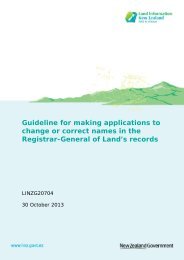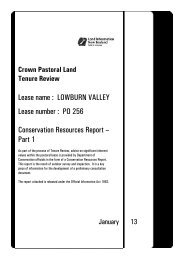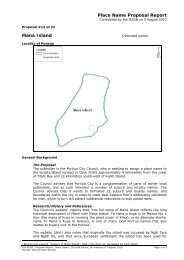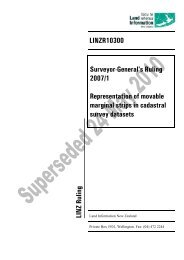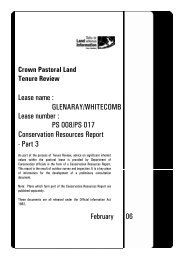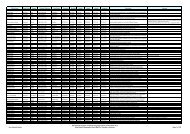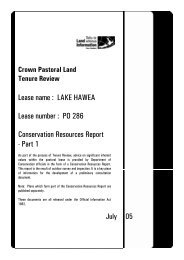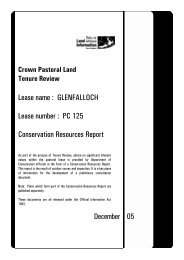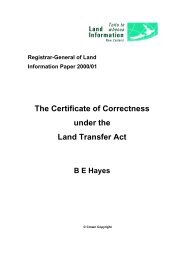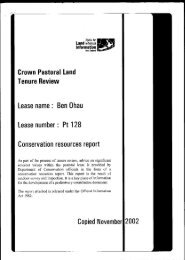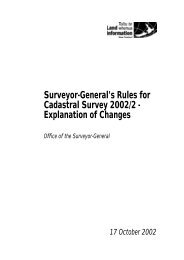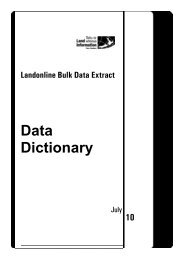Middle Hill Pastoral Lease - Land Information New Zealand
Middle Hill Pastoral Lease - Land Information New Zealand
Middle Hill Pastoral Lease - Land Information New Zealand
You also want an ePaper? Increase the reach of your titles
YUMPU automatically turns print PDFs into web optimized ePapers that Google loves.
“RELEASED UNDER THE OFFICIAL INFORMATION ACT”<br />
Along the slopes north and northwest of spot height 977 m is a substantial boulderfield,<br />
above and below the bulldozed track. The vegetation here has been heavily modified by<br />
burning and now consists mainly of tall kanuka. In some areas the boulders are quite<br />
shallowly deposited on soils, providing few refuges for ground invertebrates to survive the<br />
heat of burning. However, in other areas the boulders are very large and there is<br />
considerable depth to the deposits. This suggests that the original forest cover would have<br />
been relatively sparse on these sites and would have provided good refuge for invertebrates<br />
during burning. At least two species of moderate-sized carabid beetles were relatively<br />
plentiful in this area.<br />
The whole of this area is considered to have high significant inherent value for invertebrate<br />
conservation, with the exception of some areas of pasture along or adjacent to the ridgeline<br />
from spot height 977 m to near spot height 1008 m.<br />
South and southwest faces of <strong>Middle</strong> <strong>Hill</strong><br />
This area covers the steep hill (spot height 805 m) southwest of <strong>Middle</strong> <strong>Hill</strong> and the small<br />
catchment on the southwest side of <strong>Middle</strong> <strong>Hill</strong>. It includes the wetlands near the airstrip<br />
and rocky outcrops on the spur west of spot height 805 m. These features, especially the<br />
wetlands, provide considerable habitat diversity on a property which has few wetlands.<br />
Given the comparative rarity of wetlands at mid altitude in the region, this area is considered<br />
to have moderate-high significant inherent value for invertebrate conservation. The slopes<br />
of <strong>Middle</strong> <strong>Hill</strong> and the bed of the small stream feeding the wetland are important for<br />
protection of water quality in the wetlands.<br />
Faces above Wharekiri Stream<br />
Biologically, this is one of the more diverse areas on the property, with vegetation ranging<br />
from pasture through extensive kanuka stands to remnant podocarp forest and hardwood<br />
forest in gullies, on benches and gentler slopes on rocky faces. It also features extensive,<br />
steep to vertical rock bluffs. It includes the deep gorge within Wharekiri Stream, with both<br />
exposed and sheltered rock bluffs and extensive bluff vegetation. This area appears to<br />
provide the largest diversity of invertebrate habitats on the property.<br />
On the eastern fringe of this area, near the ridgeline between spot heights 251 m and 489 m,<br />
a specimen of the rare darkling beetle Mimopeus parallelus was found by team members<br />
under a cover for a lizard trap. This appears to be the first record of this species away from<br />
the dry gravel terraces closer to the Clarence Valley floor where it has been previously<br />
found. This area is considered to have high significant inherent value for invertebrate<br />
conservation.<br />
Lower Miller and Wharekiri streams<br />
Three sites were investigated for invertebrate habitat within this area: the flats with tall<br />
kanuka beside Miller Stream, a little over one kilometre upstream from the confluence of the<br />
two streams; the rocky point and associated scrub and forest covered flats separating Miller<br />
and Wharekiri streams, directly upstream from the confluence; and, the kanuka-manuka<br />
stand on the true right of lower Wharekiri Stream just above its confluence with the<br />
Clarence River.<br />
The kanuka flats furthest up Miller Stream differ considerably in character. Downstream,<br />
the kanuka has a sparse understorey, apparently strongly influenced by feral goats and/or<br />
domestic stock. Upstream the understorey is substantially thicker, with significant<br />
CHCCO-70334 - <strong>Middle</strong> <strong>Hill</strong> CRR<br />
20-5-2005<br />
31



